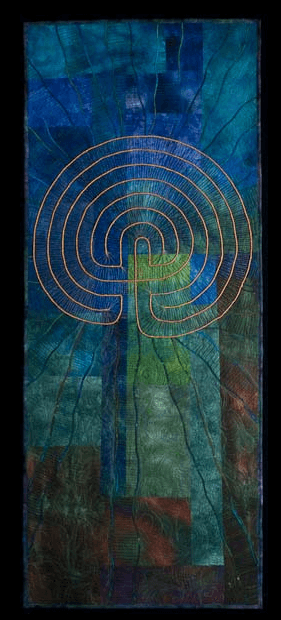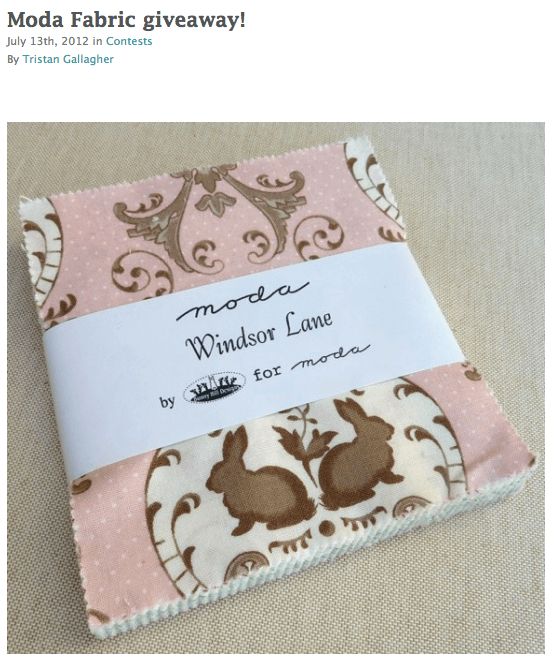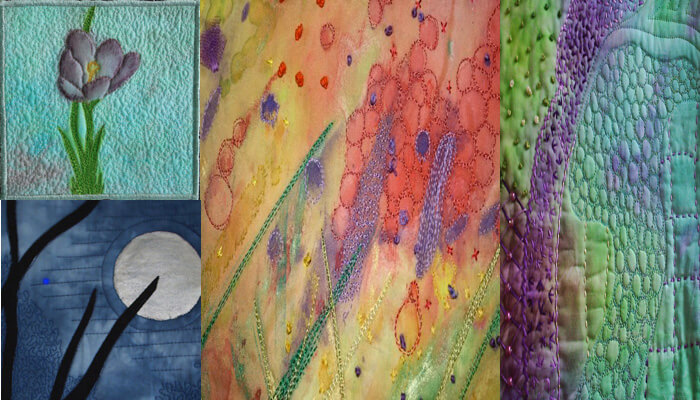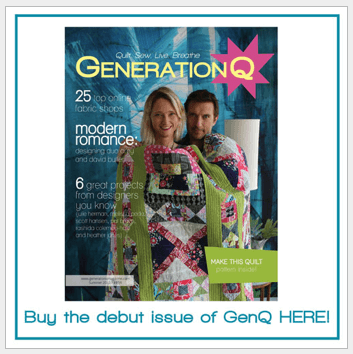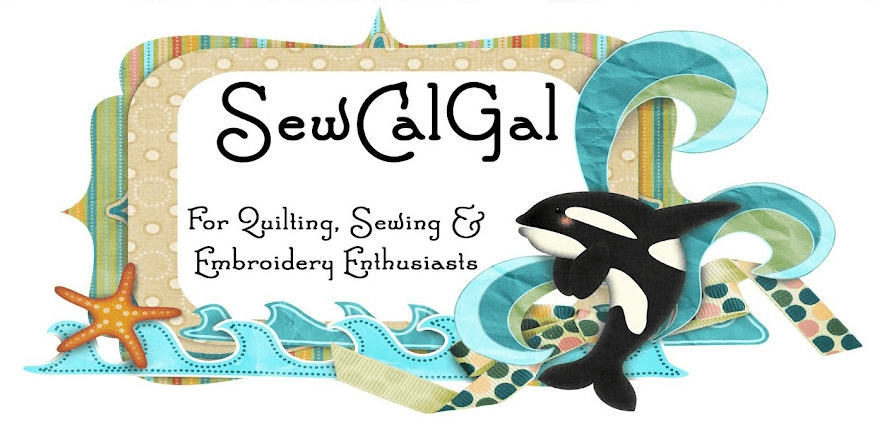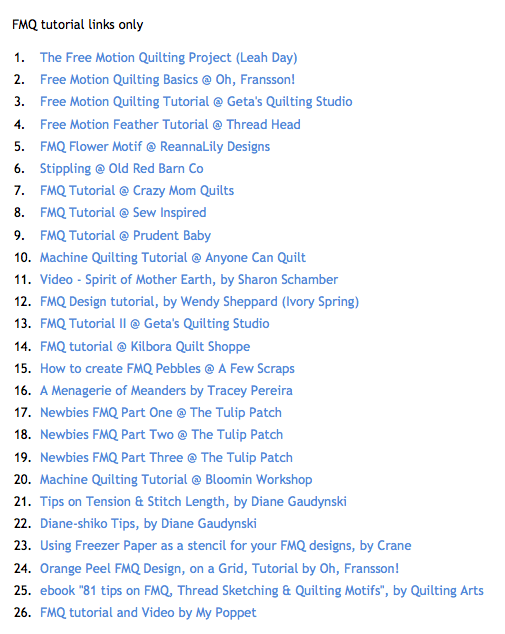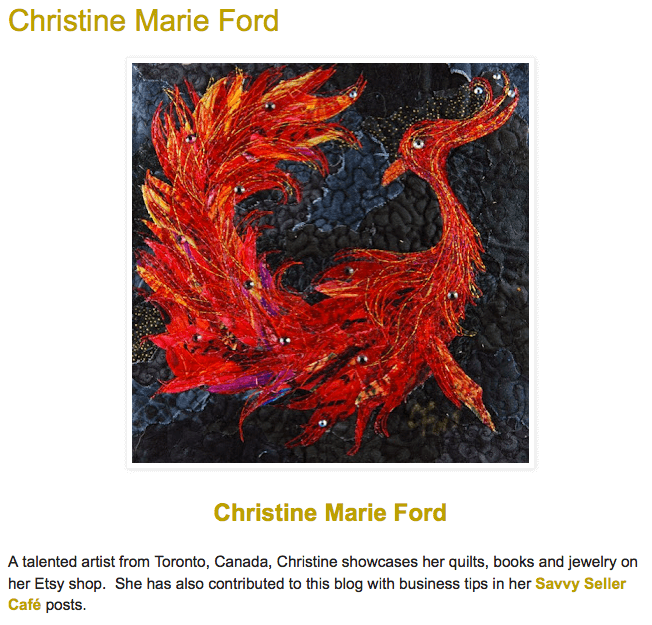Archive for the ‘art’ Category
TAFA Members – New Profiles to Check Out
The Textile and Fiber Art List is nearly 500 members! Three years as an organization this past January, thanks to our founder Rachel Biel, who is just an amazing motivator! Check out a few more profiles of very talented folks.
“I create one-of-a-kind wearable art by re-imagining gently used clothing and re-purposing them into new creations. Driven by my passion for textiles, I choose garments based on their color, texture, and quality. After cleaning and processing my finds, an organic design process occurs while exploring color and textural relationships. Gradually a new garment emerges as I cut and fit pieces together. It’s almost like playing with paints or crayons while anxiously waiting to see the finished result. My former life as a custom dressmaker and my life long love affair with arts and crafts has brought me to this new creative place of free-style sewing. I look forward to making more accessories and perhaps children’s garments.” Brenda Abdullah Designs.
“Caryl Bryer Fallert is internationally recognized for her award winning art quilts. She is best known for her organic, curved seam designs, her scintillating use of color, and her multilevel illusions of light and motion. Her attention to detail has earned her a reputation for fine craftsmanship as well as stunning designs. In 2000 Caryl was selected as one of the 30 most influential quilt makers in the world, and her quilt Corona #2: Solar Eclipse was voted one of the 100 Most Important Quilts of the Twentieth Century. She was chosen for the Bernina Leadership Award in 2003 and in 2004 the readers of American Quilter Magazine voted her “All American Quilter.” She is the 2006 recipient of the International Quilt Festival Silver Star (lifetime achievement) Award. Since 1983, Caryl’s work has been exhibited extensively throughout North America, Europe, Japan, and the Pacific Rim. She has had ninteen solo exhibitions, including a 1992 exhibition in Tokyo, Japan, and a 2000 exhibition in Burlington, Ontario, Canada. Caryl is the only three-time winner of the coveted American Quilters Society Best of Show, Purchase Award. She was the 2009 International Quilt Festival Best of Show winner, and her quilts have also been awarded Best of Show in more a dozen other national and international exhibitions. In 1986, Caryl received the Masterpiece Quilt Award from the National Quilting Association. She has received the Master Awards for both Contemporary Artistry (2002 & 2006) and Machine Artistry (1997) from the International Quilt Association and Best Machine Workmanship from the American Quilters Society (2004 & 2009) and the Quilting the Quilt national exhibition (2003). Caryl has authored two books, and numerous workshops on CD-ROM. Her quilts have appeared in hundreds of national and international publications, including the covers of the 1987 and 1991 Quilt National Catalogs. Caryl’s work can be found in public, museum, corporate, and private collections in twenty-two states and seven foreign countries. Collections include: The Museum of Art & Design (NY,NY), Illinois State Museum, National Quilt Museum, International Quilt Study Center, Wilmette (IL) Public Library, Bradley University Library, Glendale (CA) Civic Center, Fidelity Investments Inc., Sprint, and Fritz Gegauf A.G. (Switzerland). In addition to her commission work, Caryl reserves time to create a body of very personal, experimental quilts.” Bryerpatch Studio.
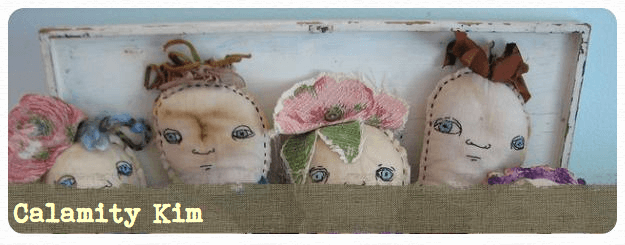 “I started weaving free form sculptural basketry back in the 80’s and 90’s. Along the way I learned paper making, wet felting and explored one of a kind teddy bears, dolls and rabbits.
“I started weaving free form sculptural basketry back in the 80’s and 90’s. Along the way I learned paper making, wet felting and explored one of a kind teddy bears, dolls and rabbits.
I learned how to embroider and quilt from my Grandmother and have had the pleasure of taking quilting classes with Jane Sassaman, Carol Doak and Lyric Kinard.
I am currently dyeing fabric with fiber reactive dyes as well as using India Flint’s Eco Dyeing techniques with silk and wool.
I learned to spin art yarn 4 years ago and have studied under Jacey Boggs and Lexi Boeger and have washed, dyed, batted and spun so much yarn that I finally had to learn to knit!
Add all of this up and you have a very eclectic, diverse and multi faceted fiber artist! I hope you will check out my links and share in my current adventures as I use my hand dyed and recycled fabrics to create gorgeous playclothes that make you look and feel creative yourself!” Calamity Kim.
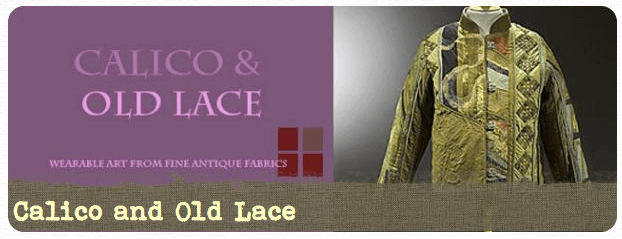 “I am an artist and a tailor. I make eclectic quilted clothing and wall hangings for office/home decor. I have been sewing and quilting for many years and hope to keep the tradition of quilting long into the future. I hope to keep heirloom quilted clothing alive into the future of wearables and hope to maintain quilting techniques for generations to come.” Calico and Old Lace
“I am an artist and a tailor. I make eclectic quilted clothing and wall hangings for office/home decor. I have been sewing and quilting for many years and hope to keep the tradition of quilting long into the future. I hope to keep heirloom quilted clothing alive into the future of wearables and hope to maintain quilting techniques for generations to come.” Calico and Old Lace
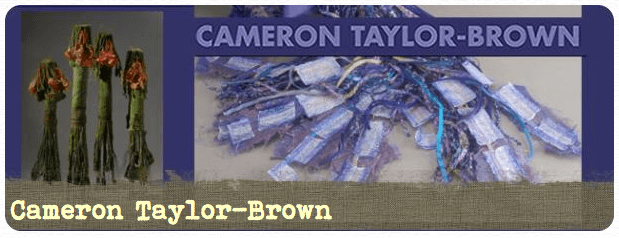 “Cameron Taylor-Brown has immersed herself in the worlds of fiber, education and commerce since the 1970s. She studied fiber art at the University of California, Berkeley with artist Ed Rossbach and textile design at the Philadelphia College of Textiles and Science. She worked in New York City as a stylist of upholstery and home furnishing fabrics, taught textile design at the Philadelphia College of Textiles and Science and worked as an exhibition curator. Since 1985, Taylor-Brown has lived in Los Angeles where she maintains a studio and is active in several arts organizations. She was a founding board member of the Textile Group of Los Angeles and a past President of California Fibers and Designing Weavers. She recently founded ARTSgarage, a new textile resource center in Los Angeles.” Cameron Taylor-Brown
“Cameron Taylor-Brown has immersed herself in the worlds of fiber, education and commerce since the 1970s. She studied fiber art at the University of California, Berkeley with artist Ed Rossbach and textile design at the Philadelphia College of Textiles and Science. She worked in New York City as a stylist of upholstery and home furnishing fabrics, taught textile design at the Philadelphia College of Textiles and Science and worked as an exhibition curator. Since 1985, Taylor-Brown has lived in Los Angeles where she maintains a studio and is active in several arts organizations. She was a founding board member of the Textile Group of Los Angeles and a past President of California Fibers and Designing Weavers. She recently founded ARTSgarage, a new textile resource center in Los Angeles.” Cameron Taylor-Brown
Membership is open and is a DEAL for what you receive and for the future potential of this organization. Here is the link for membership.
Random Thoughts on a Saturday Morning…….
Why can’t I stay caught up on my blog reading? Which I really enjoy, and I get so many cool ideas, but then other things get in the way, and I get behind, and then I feel bad….of well, just delete the 75 items from Rachel Maddow and the 138 from Al Jazeera and move on from there…….
Marbling in the big tray this morning – and tomorrow morning – first time in over 2 years we’ve done really large pieces. We have orders for some, and when the Martha Stewart article breaks, we will be (hopefully) doing a lot of ribbon pieces. We’ve had to totally reconfigure almost everything in the house to make this work. The studio is changed around, the sewing table was totally cleaned off and reconfigured, so we could move the machine easily and set marbling combs on the table. The ironing board holds all the paint. The set tub in the garage works nicely – hot water on demand (unlike the rest of the house…). We’ve got the drying racks in the garage until we are done, and then the fabric goes into the dryer. The Kitchen counters are cleaned to hold the small table ironing board for quick wrinkly pressing. My table I do my school work on is cleaned off for a cutting boards now…and hubby woke up realizing he needed a LOT more carrageenan for tomorrow’s session. The idea being if we’re going through all this, let’s get the most use out of the session as we can…….But everything is working really well.
I watch Project Runway, and most times I have no idea what I would do with the challenge….except last night as we were watching the unconventional challenge, I had ideas….for the hardware. A really cute metallic vest. Hmmmm…..what does that say about my design sense?
I hate commercials – they’re just so…so….commercial. We don’t need that stuff. Too much conspicuous consumption. That said, I am buying a new sewing machine tomorrow, a Brother, with 90 decorative stitches and a basic alphabet….for less than $200, because I am waiting until it is on special. I started sewing on my mom’s 1000-pound Singer, bought a sewing machine within the first week of landing on Maui for my first teaching gig, left it with the drama department when I moved to Vermont, bought a Singer with “stretch” stitches that I passed to my mother-in-law, who sold loads of doll clothes for the grandkids. I bought a “computerized” Singer machine that had a lot of bells and whistles, and on which I made my husband’s first – and only – leisure suit. Twelve years ago I bought my Bernina workhorse 1008, and a used Bernina serger, and ended up selling the last two machines in a yard sale. I LOVE my Bernina workhorse, but it has extremely limited decorative stitches. My work with the marbled fabrics is taking me in another direction, and this is about all I can afford at this point, so, in the immortal words of Tim Gunn, I will “make it work.” Phew……
I do tend to believe in conspiracy theories – you will never convince me there was not another shooter on the grassy knoll. That said, I’m wondering about the Pope. I think there’s huge amounts of back-stories on him that are just now being hinted at. Dan Brown could have another interesting “Angels and Demons” if he wants. I want to know how the Hitler Youth played into his background. Granted, the church teaches about forgiveness, but inquiring minds….and just what is the Italian government after? The Catholic church will never be able to do enough to wipe away the stain of sexual abuse…..well, maybe making a woman pope would do it…….
I told you I would be rambling. Each time I take a break from the marbling process and sit here, something else is floating through my head…….
I seem to be falling behind on lists and blogs, and yet I am getting stuff accomplished. I finished a whole cloth fmq as a commission for a friend, and it turned out wonderfully. I have three other pieces backed and ready for the machine. The website has the ordering page done for the ribbons, I am staying up with college algebra teaching, and yet I don’t feel organized. I am meeting deadlines – two books in the works with some of our work, for example. But I am bogged down mentally. Part I am sure is not being back at yoga on a regular basis, and not getting the home practice of yoga back to daily. Too much sugar is definitely affecting moods. I want to travel – and I don’t want to have to wait until July to take off. Lately I seem to be really missing Hawaii – and New England, although not the snow and cold. Evidently I just need to “go with the flow,” as I am getting things done…..but the damn Autumn pattern is still not complete……………………………………
52 Sparks – Week 4 – Aloneness
This was an interesting question this week: How do you feel when you are by yourself?
I spend a huge amount of time time by myself, usually working on something artistic. It seems like I have always been by myself growing up…and yet, you can never be by yourself when you have a good book. And that is still true.
But I never had a lot of friends. I am quite the introvert, so moving to something artistic just seemed a natural. I think my introversion became even stronger, given my position in a family of extroverts, coupled with emotional abuse. So I am accustomed to being by myself. My husband and I do most everything together – we are each other’s best friend. The fact that we can – and do – work at art together is a great plus for us.
I can remember my dad asking me how I was, one time when he came to visit. I said I was lonely. I did a lot of things by myself, and I could always read, but I think it was more a case of seeing friends with others of the opposite sex, and I would wonder what was wrong with me. I finally decided if I was going to be single, then it would not keep my from doing whatever I wanted to do. Alone can be very good – I get a lot of work done on fiber pieces, a lot of planning. Especially with retirement. So when I do have “alone” time, I plan projects or lose myself in a good book.
So since I haven’t started something new, I decided to try a “whole cloth” quilt because of the class I’m taking on Craftsy with Cindy Needham. I had the really great stencil from about 12 years ago…..I finally found where I had “stored” it. I pulled a green piece with some interesting tonal print to see what would happen. Here’s the latest “in progress:”
Of course, most of the yellow marker has already rubbed off…….
8-0-1….801 Posts – Oh My!
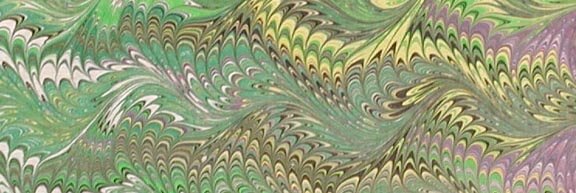 Wow. I have written 800 blog posts since I started some years ago…..January of 2007. I figured I’d keep the blog just for posting with the Photoshop class I was taking, but I’ve come to really enjoy writing and reflecting. Like a diary, which I could never seem to do when I was younger. But now I can look back, see how my art has grown, reflect on different pieces. It is amusing to see some of the very beginning Photoshop pieces:
Wow. I have written 800 blog posts since I started some years ago…..January of 2007. I figured I’d keep the blog just for posting with the Photoshop class I was taking, but I’ve come to really enjoy writing and reflecting. Like a diary, which I could never seem to do when I was younger. But now I can look back, see how my art has grown, reflect on different pieces. It is amusing to see some of the very beginning Photoshop pieces:
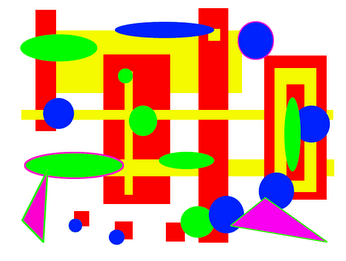 I was pretty thrilled with that first attempt….little did I know what I still needed to learn about layers!
I was pretty thrilled with that first attempt….little did I know what I still needed to learn about layers!
This next taught me a lot about luminescence, even though I didn’t know it at the time!
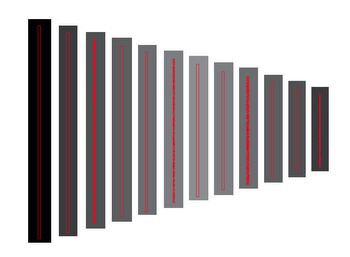 I really liked the examples I first posted some 6 years ago. I look at tyhem now and see that part of why I liked them was that they really showed some of the principles of design. I just didn’t know it at the time.
I really liked the examples I first posted some 6 years ago. I look at tyhem now and see that part of why I liked them was that they really showed some of the principles of design. I just didn’t know it at the time.
I’ve also been able to document a lot of our marbling through the web page, and I do need to do more of that, since we are building our audience significantly. That said, here’s a look at just one of the pieces we turned out on Tuesday this week.
Putting the layers of paint on the carrageenan size:
Starting the pattern with our personally-made “high tech” tools:
The nonpareil pattern – a very traditional pattern created after about four previous steps:
Looking at the pattern from the back side, after the fabric (on orange Kona cotton) had been laid on the size:
Here it is from the front:
It’s been a good week!
Top Ten Tuesday
 Sometimes it takes two weeks to collect everything, but I always find some gems – I LOVE the internet!
Sometimes it takes two weeks to collect everything, but I always find some gems – I LOVE the internet!
From the 365 Project comes another gorgeous set of photos…some of them very subtle and delicate.
One of the amazing people I adore – Sidney Poitier, from Letters of Note:
From Raymond Houston comes a free download for a circular Celtic knot. This would make a great Christmas wreath, and I LOVE the fact that he analyzed a blog post that was very popular to see what people were looking at. I gotta try this in marbled fabric next year!
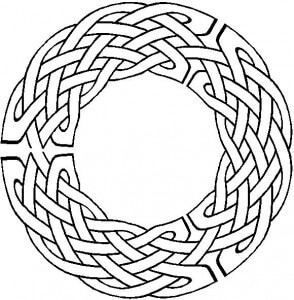 Since most of us are dealing with cold weather right now (in the desert it was 18 F today – REALLY cold for us!), here’s an interesting video of boiling water freezing almost instantly…..and the accompanying science article to explain it.
Since most of us are dealing with cold weather right now (in the desert it was 18 F today – REALLY cold for us!), here’s an interesting video of boiling water freezing almost instantly…..and the accompanying science article to explain it.
A teacher friend of mine is looking for some online lessons to help teach punctuation……and here’s my absolutely favorite one. Some of you will remember this – the immortal Victor Borge….
Another cool artist and how he does it – disappearing into the background……The link will take you to Liu Bolin – can’t seem to embed this one…..then go to this new link to see some additional photos of his work. (Look for his shoes at the bottom….)
Very clever idea on creating a photo booth – would be great for kids’ parties! From Alisa Burke, who does very cool things!
Readers of these posts know I love the 365 Project. They have a post up on motivating and organizing yourself to participate in the project. Some great ideas for photographers.
I LOVE flash mobs – even if they are commercials – I nearly always get teary eyed. Here’s one from T-Mobile….
And finally, Star Trek fans – did you know Dr. Martin Luther King, Jr. was a fan? Think of how the series would have changed if he had not talked Uhuru into staying…….
Have a great week! Send me cool stuff you find online!
Thoughts from Robert Genn – the Stendhal Syndrome
I am a subscriber to Robert Genn’s Twice Weekly Letter, and this one really said something to me. The Stendhal Effect is described as “the condition of being dangerously overwhelmed by beauty in either art or nature.” I thought it was just me having heart palpitations in a great quilt store. I can walk out of a gallery energized by the amazing glass – or paintings – or woodwork – or fiber. A great quilt show leaves me breathless. A Monet exhibit has my heart rate decrease to a pleasant sense of peace. A visit to the Getty Museum leaves me so excited and overwhelmed I can calm down till way past my bedtime. And yes, great quilt stores give me heart palpitations.
So it turns out there is an actual, identified condition, called the Stendhal Syndrome. It was “first described in 1979 by the Italian psychiatrist, Gaziella Magherini, after studying more than 100 cases among visitors to the Uffizi in Florence. A concentration of particularly beautiful art can cause rapid heartbeat, dizziness, confusion and even hallucinations.” What angers me is that with the decline of the arts in the schools, more and more students will never experience this. What I also find interesting is a related condition that strikes me at historical landmarks. I first realized it when I walked the Gettysburg Battlefield in the summer of 1974. I was overwhelmed with the place – I looked around, listened to the wind, and imagined all the soldiers fighting those three days. This happens whenever I visit something of historical significance. Standing in Fanueil Hall in Boston where Adams and other early leaders of the American Revolution stood kept me transfixed for nearly half an hour. Antietam – imaging the streams running red and soldiers staring as I walked. Sitting in a small room on the third floor of the American History Museum of the Smithsonian, watching three hours of newsreels from World War II because I couldn’t tear myself away. Watching the oil seep to the surface while standing on the Pearl Harbor Memorial, and wiping away tears, standing on the rocks by Lindbergh’s grave on Maui, and standing on the great Wall of China, staring off toward Mongolia.
Nature will also always do this to me. Looking up at a redwood until my neck gives out, the Grand Canyon, Point Loma, Fisherman’s Wharf, the mountains of Guilin, the Oregon Coast – there are so many places where I can just stand and stare and cry, it is just so beautiful. So art, nature, or that historical moment can overwhelm me so. I wish that for so many more people.
Even More from The Textile and Fiber Art List!
Oh, for an endless amount of money to spend on art! TAFA is like my own private store, and I WANT WANT WANT everything I see. Enjoy these new artists this week.
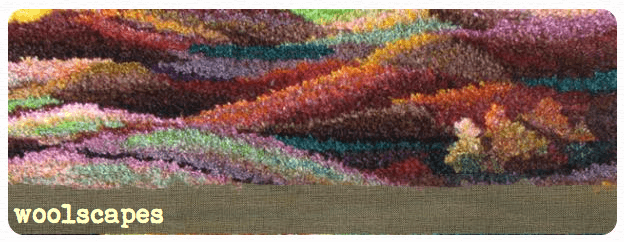 From Hana: “Weaving technology is the use of woolen thread on mesh canvas with the aid of a hook. The weaving in itself is accomplished in free flow on a direct path from the “picture in one’s mind” to the canvas, without a previously drawn sketch on paper or canvas. This type of work enables maximum spontaneity and allows for a free flow of mood and color within the framework of the subject on the one hand (desert landscape for example) but on the other hand, enables the carpet to evolve and “breathe” in the process of its creation. In addition to weaving wall carpets I also paint, mostly oil on canvas but I use other techniques as well. My paintings are strictly figurative and very different from my carpets. While the carpets essentially try to convey the mood of a landscape through the free and more abstract use of form and color the paintings are either portraits or still life scenes that emphasize the composition of the scene or the mood of the person in the portrait. The colors I use in the paintings are not as bright as those I use in the carpets and they have a more introvert and subdued nature.” Woolscapes
From Hana: “Weaving technology is the use of woolen thread on mesh canvas with the aid of a hook. The weaving in itself is accomplished in free flow on a direct path from the “picture in one’s mind” to the canvas, without a previously drawn sketch on paper or canvas. This type of work enables maximum spontaneity and allows for a free flow of mood and color within the framework of the subject on the one hand (desert landscape for example) but on the other hand, enables the carpet to evolve and “breathe” in the process of its creation. In addition to weaving wall carpets I also paint, mostly oil on canvas but I use other techniques as well. My paintings are strictly figurative and very different from my carpets. While the carpets essentially try to convey the mood of a landscape through the free and more abstract use of form and color the paintings are either portraits or still life scenes that emphasize the composition of the scene or the mood of the person in the portrait. The colors I use in the paintings are not as bright as those I use in the carpets and they have a more introvert and subdued nature.” Woolscapes
 From Wil Opio Oguta :”Inspiration for the quilts I make comes from a variety of sources. It can be nature, an expression, a color or a material. For most of my quilts I use my own hand dyed fabric. My quilts can be very colorful or simply black and white. I work in a contemporary style, but have no objection at all to incorporating traditional blocks. Often I use raw edge appliqué, but don’t be surprised if I switch techniques for another quilt. I love working with fiber, but if the quilt wants/needs it, I add other materials to it. This can be bark, buttons, lutrador and paint. It all depends on what I feel is needed. For me, making art quilts is a way of expressing what I see, translating the world into fabric and fibers, emphasizing/focusing on what is important to me and to show you how I feel about it.” WilOpioOguta
From Wil Opio Oguta :”Inspiration for the quilts I make comes from a variety of sources. It can be nature, an expression, a color or a material. For most of my quilts I use my own hand dyed fabric. My quilts can be very colorful or simply black and white. I work in a contemporary style, but have no objection at all to incorporating traditional blocks. Often I use raw edge appliqué, but don’t be surprised if I switch techniques for another quilt. I love working with fiber, but if the quilt wants/needs it, I add other materials to it. This can be bark, buttons, lutrador and paint. It all depends on what I feel is needed. For me, making art quilts is a way of expressing what I see, translating the world into fabric and fibers, emphasizing/focusing on what is important to me and to show you how I feel about it.” WilOpioOguta
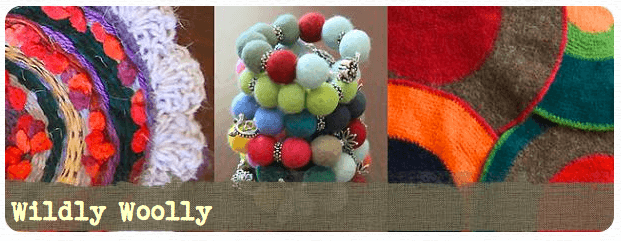 From Kim Buchheit: “Kim is a designer and artist living and working in Grand Canyon National Park. Her love of felt is rooted in an affection for its understated beauty, a fondness for the old-world craft of felt-making, and the simple earth-and animal-friendly nature of the materials used in the process.” Wildly Woolly
From Kim Buchheit: “Kim is a designer and artist living and working in Grand Canyon National Park. Her love of felt is rooted in an affection for its understated beauty, a fondness for the old-world craft of felt-making, and the simple earth-and animal-friendly nature of the materials used in the process.” Wildly Woolly
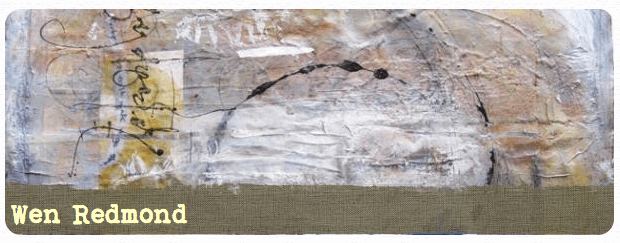 From Wen Redmond: “I am quite passionate about my work. I continue to explore my chosen medium, fabric, to see what it can do, to stretch its perception as art medium. When I work, I encourage a collaborative process with spirit or my higher self, that mind-boggling principle of the universe. This process can also be called ‘flow’. When you are in this state of mind, the intuitive is tapped and the work can become more than the sum of it’s parts. I work out insights, inspirations, feelings and reactions to the outer world. Allowing time for these inspirations to percolate up from my unconscious is a vital part of my process. Each piece is wrought individually and is one of a kind. These include original photographs, artistically manipulated, printed on prepared fabrics and various textile substrates. The works can include painting, dying, stamping screen-printing, mono printing and other means of surface design. Among a variety of presentations, I created an innovative technique, Holographic Images, employing photographs on silk organza to create a unique 3-D effect. Layers peeled back reveal the source, the inspiration, and my mad desire to capture thoughts, dreams and the beauty of nature. ” Wen Redmond
From Wen Redmond: “I am quite passionate about my work. I continue to explore my chosen medium, fabric, to see what it can do, to stretch its perception as art medium. When I work, I encourage a collaborative process with spirit or my higher self, that mind-boggling principle of the universe. This process can also be called ‘flow’. When you are in this state of mind, the intuitive is tapped and the work can become more than the sum of it’s parts. I work out insights, inspirations, feelings and reactions to the outer world. Allowing time for these inspirations to percolate up from my unconscious is a vital part of my process. Each piece is wrought individually and is one of a kind. These include original photographs, artistically manipulated, printed on prepared fabrics and various textile substrates. The works can include painting, dying, stamping screen-printing, mono printing and other means of surface design. Among a variety of presentations, I created an innovative technique, Holographic Images, employing photographs on silk organza to create a unique 3-D effect. Layers peeled back reveal the source, the inspiration, and my mad desire to capture thoughts, dreams and the beauty of nature. ” Wen Redmond
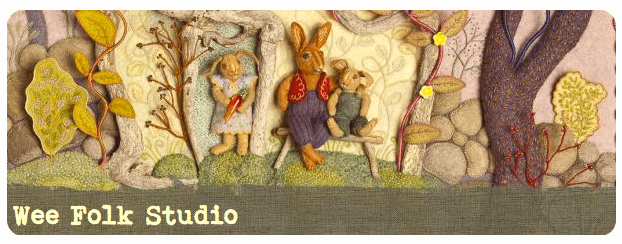 From Salley Mavor: ” have had a life-long fascination with little things and needlework. Toward the end of art school, I rediscovered my childhood delight in sewing and creating miniature scenes. Leaving traditional illustration mediums behind, but still interested in narrative work, I taught myself stitching and fiber art techniques. For me, manipulating materials with my hands with a needle and thread was so much more satisfying than rendering with a pencil or brush. I found that I could communicate my ideas more clearly this way and that my hands would direct me in a compelling way. My early pieces were soft sculpture, and then turned flatter, with raised figures and objects on a fabric background. I came up with the term “fabric relief” in 1982 to better describe my evolving technique. My 3-dimentional pictures resemble miniature, shallow stage sets, with scenery, props and characters telling a story. I embroider, wrap, appliqué and paint different materials and found objects to create scenes in relief, with figures imposed on an embellished fabric background. My work is decorative and detailed, full of patterns from nature, all stitched by hand. For the past 20 years, I’ve been working in the field of illustration, making artwork which is then photographed and printed in children’s books. The original fabric relief pictures have a second life when they are mounted and framed under glass in shadow boxes, ready to display as individual pieces. ” Wee Folk Studio
From Salley Mavor: ” have had a life-long fascination with little things and needlework. Toward the end of art school, I rediscovered my childhood delight in sewing and creating miniature scenes. Leaving traditional illustration mediums behind, but still interested in narrative work, I taught myself stitching and fiber art techniques. For me, manipulating materials with my hands with a needle and thread was so much more satisfying than rendering with a pencil or brush. I found that I could communicate my ideas more clearly this way and that my hands would direct me in a compelling way. My early pieces were soft sculpture, and then turned flatter, with raised figures and objects on a fabric background. I came up with the term “fabric relief” in 1982 to better describe my evolving technique. My 3-dimentional pictures resemble miniature, shallow stage sets, with scenery, props and characters telling a story. I embroider, wrap, appliqué and paint different materials and found objects to create scenes in relief, with figures imposed on an embellished fabric background. My work is decorative and detailed, full of patterns from nature, all stitched by hand. For the past 20 years, I’ve been working in the field of illustration, making artwork which is then photographed and printed in children’s books. The original fabric relief pictures have a second life when they are mounted and framed under glass in shadow boxes, ready to display as individual pieces. ” Wee Folk Studio
Wednesday Work in Progress
Lots of work redoing the website – looking at old pictures, seeing how far we have come, and it’s been quite the journey. I tend to get obsessive on these things, and I am now trying to rein myself in….not every piece we’ve ever done has to be on the site, but I want a good representation. This site has served as an online portfolio, and it’s been great. Now I want to expand into other information, as well as attempt to rev up the sales portion on the site. Many thanks to web guru Suzan of Saltwater Systems – nothing short of amazing!
We’ve added more fabric samples so people get a better idea of what can happen with marbling. You can see that here. We could add so many more from our pile of “Never Sell These,” but this gives a good idea.
Also, I’ve added small pieces we’ve worked on to the Small Works page. I do like working in a 12-inch-square format, and I want to do more of that when some of the bigger projects are finished.
My Nature series has really grown, and as I look at all the pieces together, I can see how I am really drawn to quilting the traditional stone pattern. I want to do more with the bouquet and nonpareil patterns, and I have the perfect piece of red cotton that has started calling me. In the meantime, I’m practicing my machine quilting on some smaller quilts. My Christmas quilt is almost redone – I succeeded in accenting the stars. I need to sew the binding, so hopefully a reveal in another couple of days.
It’s great to be so busy….we have a major order we are marbling in the next few days, and it’s a secret at this point….but it’s for a magazine feature…………….
Why Algebra? (Hey, don’t click away from here….you’ll miss the rant….)
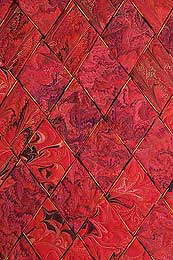 SO….I was awake early morning composing the start to this small rant. Yesterday a former retired colleague posted that he, the art teacher, had subbed for a math teacher and within five minutes had convinced all the students that algebra was pointless in their lives. My quick Facebook comment was something like “oh, so NOT true….”
SO….I was awake early morning composing the start to this small rant. Yesterday a former retired colleague posted that he, the art teacher, had subbed for a math teacher and within five minutes had convinced all the students that algebra was pointless in their lives. My quick Facebook comment was something like “oh, so NOT true….”
As I pondered this during the night, I thought of a bunch of things. That math teacher who has struggled all year trying to convince most of the students that algebra is worthwhile just had his job made so much harder. If a math teacher subbed in an art teacher’s classroom and said “why do art because it’ll never make you any money,” he/she has effectively destroyed a lot of budding artists.
Kids listen to what adults say. Now I’m coming at this rant from both angles. I teach college algebra one morning a week at The Art Institute of Tucson. Art and Math, so there. I really work at developing mathematical examples that are applicable to adult students, many of whom see no point to college algebra. So let’s take a look at the practical applications of algebra and all its rules in real life.
1. Order of operations (PEMDAS): if you’re an artist, you don’t pick out your matting before the painting is done. If you’re a chef, you know certain recipes HAVE to be done in a certain order or you ruin the dish. In real life you don’t put your underwear on last. Life is governed by some basics, and that’s what order of operations is all about. This principle teaches you to look for and use order. If you’re designing a video game or a movie, a story board is pretty darn important. Some things have to happen first before others.
2. Algebra teaches you to think: boy, do students hate this one, but it’s true. There is order in life, and algebra is an exercise that gets us to see what we have to do first, second, and so on. Solving equations is all about thinking through the problem and following a set of steps. Reading directions is much the same (even if you’re like my hubby and try to intuit what comes first….) Laying out a sewing pattern for cutting is thoughtful. If you think of a menu for an event as an equation, you realize that you have to proceed through the preparation pretty thoughtfully.
3. Combining like terms: think about recipes and ordering. One recipe calls for three cups of flour, another for 2 cups of flour, and the third one just a couple of tablespoons. Do you order each separately? Hopefully not, because that would be tedious and time consuming and probably not cost effective. That’s what combining like terms is all about. 3A + 5B + 2C = 240 could be your supply order and total amount for an event, an art project. Think about planning your art budget for the year for your classroom. You are ordering construction paper….you break it down to amount of packages of each color needed, and then you end up combining all the construction paper before going on to think about your paints. Then you total everything for the final amount. Combining like terms….
4. Exponential functions: recognizing these functions is pretty darn important if you are buying a car, a house, or medicine, just to name a few.
You better hope your pharmacist understands how long certain meds stay in your bloodstream before you have to take a new dose. Or…do you understand just how much you are paying in a car loan per month (which is linear) and how the time of your loan affects the value of your car (exponential). And if you want to win the big lottery……
5. Quadratic functions: aside from the fact that the makers of Angry Birds are making a small fortune using quadratic functions to create a game, anyone who has done anything in sports will recognize that a golf swing, a basketball shot, a baseball swing, a forward pass with recognize the inevitable parabola created.

http://www.mathamazement.com/Lessons/Pre-Calculus/02_Polynomial-and-Rational-Functions/quadratic-functions.html
You better hope your professional sports coach understands the equations that will improve your abilities.
So just a few examples……I could go on, but hopefully I’ve made a convert or two. And…just because…here’s a classic Abbot and Costello routine to show just how easily math can be misunderstood…..
May the Algebra Force be with you……….
TAFA Eye Candy – Part 5
 I have so enjoyed doing these posts each week. I get so inspired by color and design from the over 450 artists on the TAFA list…..and I’ve only been through 20 artists! And now, Rachel, our list mom and guiding light, has taken photos from us and set up a TAFA gift store on Zazzle. Gorgeous stuff!! More items going up all the time.
I have so enjoyed doing these posts each week. I get so inspired by color and design from the over 450 artists on the TAFA list…..and I’ve only been through 20 artists! And now, Rachel, our list mom and guiding light, has taken photos from us and set up a TAFA gift store on Zazzle. Gorgeous stuff!! More items going up all the time.
And now some more artists…..
 “The mission of Zeni Design Studios is to create simple designs using luxurious and sometimes unexpected combinations of textiles that my customer will enjoy for many years to come. As a result, all of my designs have the customer in mind throughout the design and fabrication process. Environmental Commitment – In an ongoing desire to respect the environment, when available, organic, up-cycled, environmentally friendly and socially responsible materials are used. ” Zeni Design Studios
“The mission of Zeni Design Studios is to create simple designs using luxurious and sometimes unexpected combinations of textiles that my customer will enjoy for many years to come. As a result, all of my designs have the customer in mind throughout the design and fabrication process. Environmental Commitment – In an ongoing desire to respect the environment, when available, organic, up-cycled, environmentally friendly and socially responsible materials are used. ” Zeni Design Studios
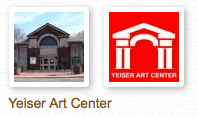 “The Yeiser Art Center, founded 1957, is a non-profit visual arts gallery located in the historic Market House in downtown Paducah, Kentucky. Exhibitions and events organized by the Yeiser are designed to serve citizens of and visitors to our region and feature quality works by established and emerging artists. Our permanent collection, exhibited periodically, is at the core of our educational mission to provide a variety of visual arts experiences to students of all ages.” Yeiser Art Center This is a must-visit for our trip east next summer!
“The Yeiser Art Center, founded 1957, is a non-profit visual arts gallery located in the historic Market House in downtown Paducah, Kentucky. Exhibitions and events organized by the Yeiser are designed to serve citizens of and visitors to our region and feature quality works by established and emerging artists. Our permanent collection, exhibited periodically, is at the core of our educational mission to provide a variety of visual arts experiences to students of all ages.” Yeiser Art Center This is a must-visit for our trip east next summer!
 “I’ve been tatting over 30 years, and designing and selling tatted jewelry since 2004. Magazine articles featuring my tatted jewelry have appeared in Bead&Button (April 2012) and Belle Armoire Jewelry (Winter 2009). I am the author of the book Tatted Jewelry published 2011 by Annie’s Attic, as well as 2 self-published books: Up and Tat ‘Em (2010) and Boutique Tatting (2008). I teach an online Shuttle Tatting course at http://www.craftsy.com/shuttletatting and hope to help many people learn to tat. ” Yarn Player
“I’ve been tatting over 30 years, and designing and selling tatted jewelry since 2004. Magazine articles featuring my tatted jewelry have appeared in Bead&Button (April 2012) and Belle Armoire Jewelry (Winter 2009). I am the author of the book Tatted Jewelry published 2011 by Annie’s Attic, as well as 2 self-published books: Up and Tat ‘Em (2010) and Boutique Tatting (2008). I teach an online Shuttle Tatting course at http://www.craftsy.com/shuttletatting and hope to help many people learn to tat. ” Yarn Player
 “Inese Liepina graduated from the School of the Art Institute of Chicago with a Bachelor of Fine Arts degree in 1980. Inese relished her years at SAIC and attempted to learn techniques in as many disciplines as possible. Majors were in fiber/fabrics and ceramic sculpture. Inese has explored glass blowing since 1991 while working as a fashion, textile, and interior designer. In the late 70’s SAIC emphasized originality along with an mentality of “breaking the rules” in art. This influence follows Inese in all her work, and she studied glassblowing technique only to learn how the rules can be broken to fit her ideas. ” Wrapture by Inese
“Inese Liepina graduated from the School of the Art Institute of Chicago with a Bachelor of Fine Arts degree in 1980. Inese relished her years at SAIC and attempted to learn techniques in as many disciplines as possible. Majors were in fiber/fabrics and ceramic sculpture. Inese has explored glass blowing since 1991 while working as a fashion, textile, and interior designer. In the late 70’s SAIC emphasized originality along with an mentality of “breaking the rules” in art. This influence follows Inese in all her work, and she studied glassblowing technique only to learn how the rules can be broken to fit her ideas. ” Wrapture by Inese
 “Like so many others, I was brave and comfortable with my creativity when I was younger, but misplaced that understanding as I became an adult. A diagnosis of cancer re-ignited my passion through a wonderful program called Art as Medicine, offered by the Cross Cancer Institute to patients, health care professionals, and their supporting friends and family. I once was a professional musician, and have re-discovered my love of singing through the vocal music program, but also my love of creating things with my hands. I am very involved now in building a cancer wellness and support facility called Wellspring Edmonton that will supplement our overburdened cancer care system, and where I hope to help others touched by cancer to express their feelings through arts-based programs. ” Wooly Boulevard
“Like so many others, I was brave and comfortable with my creativity when I was younger, but misplaced that understanding as I became an adult. A diagnosis of cancer re-ignited my passion through a wonderful program called Art as Medicine, offered by the Cross Cancer Institute to patients, health care professionals, and their supporting friends and family. I once was a professional musician, and have re-discovered my love of singing through the vocal music program, but also my love of creating things with my hands. I am very involved now in building a cancer wellness and support facility called Wellspring Edmonton that will supplement our overburdened cancer care system, and where I hope to help others touched by cancer to express their feelings through arts-based programs. ” Wooly Boulevard
Enjoy! More next week……
Nerve Endings, and Other Assorted Thoughts…..
Well, it’s been an interesting bunch of days. After thinking I was on a roll, with blog posts in the queue and lots happening, I an felled by lowered ilium and severely twisted muscles and sciatic nerve in the left leg. To the point that I have been flat on my back, unable to walk on my left leg, kinda loopy from the pain killers, and hobbling for another visit to the chiropractor tomorrow. The lump the size of a golf ball (according to hubby) has disappeared, and things are on the mend, I was able to get a lot of loose ends done today, but I am still in a fair amount of pain.
Bummer.
A lot of good things have been happening, and now I have a couple of major deadlines to meet in the next two weeks that should drive some good traffic to the blog, website, and hopefully result in some orders. I just have to be able to do the work.
Two major guest-posts for blogs, a new online gallery, a major website revision, more fabric to make, and some patterns to finish. Momentum is developing, which is exactly what I want, bvut I need to keep up with it. Nice problem to have, especially if nothing is keeping you from working.
So I did a brain dump of everything I could think of that needed to be done this week…and then some. Lots of little things got done today, and tomorrow I will prioritize the major pieces after our marbling session. Usually I get all the little things done, ’cause it looks so good having everything crossed off. But THIS TIME I have to prioritize for my deadlines.
Should be a great – and BUSY – week!
Analyzing an Artist – Jacob Lawrence
 Part of Lesson 2 is to look at designs in terms of basic elements of art. I chose Jacob Lawrence, as I have always been drawn to his paintings, both for story and simplicity. I saw a retrospective of his work at the Museum of Art in Houston the year I went to Quilt Market. All of his WWII paintings were grouped together, so you really got the narrative of that work.
Part of Lesson 2 is to look at designs in terms of basic elements of art. I chose Jacob Lawrence, as I have always been drawn to his paintings, both for story and simplicity. I saw a retrospective of his work at the Museum of Art in Houston the year I went to Quilt Market. All of his WWII paintings were grouped together, so you really got the narrative of that work.
I am very much a novice at doing this kind of critique – I always feel hampered by the lack of any formal art training, but I am curious to know why something appeals to me. So here goes. These paintings are a selection from a blog post on The Ragged Cloth Cafe, by Jane Davila.
Such a simple task and so lovely in composition. The vertical lines of the figures unify the painting, as do the irons. The lines of the irons are different, indicating the various stages of pressing. You can see the tension in each woman as she goes about her task, possibly as a result of the angles of the irons and the bent/angled heads in concentration. Balance and proportion: the irons seem very large, but they may be because I am looking at them from a modern perspective. I’ve never had to use heavy irons, and perhaps they were that big. The women dominate the painting, but I like that. This is “women’s work,” and that domination shows that. There is a lot of repetition in the postures, as well as in the background. I can almost get a “sweatshop” feel, and I get an image of the women from the movie The Help working and talking together. Perhaps the repetition helps to show community. Economy: again a simple task and a simple composition, but the focus is on the main idea. I can see the blue of the upper right pulling the eye to two of the ironed pieces; same for the orange and red in the upper left. The women themselves are dressed similarly, perhaps to indicate the uniform of the job. The more I look at this the more I see the strength and movement in the women, in their arms, the irons, their heads.
Now this next painting is one that doesn’t particularly appeal to me.
I find the colors very jarring, not at all harmonious. So many diagonals that my eye doesn’t want to rest at all. Again, a simple task at the barber shop, but there doesn’t seem to be the rhythm to the task as in the above painting. Unity/harmony: seems to be only in the main idea, that of a busy barbershop. Skin color is a unifying element. The faces seem to be the last thing you notice, just a few lighter lines. Interesting, in that may be a comment on the invisibility of the black community or the black man. Please note I am making that comment strictly from a white historical perspective. In terms of variety/tension, there certainly is a lot going on in this painting, indicating to me a very busy barber shop, and yet, now that I’ve noticed it, one man is smoking – that little bit of white draws your eye to the center of the painting. Balance/proportion: the piece seems very heavy on the bottom, big heavy dark triangles. The shampoo capes (for lack of a better term) are too many colors for my taste, and I think that’s what throws everything off for me.
Interesting exercise. I like having a selection of terms to work with, and I found I saw more in the painting the more I looked at it. But nothing beats seeing the work in person! What else can you add to the analyses? Comments welcome!
Second Design Photo Analysis
I worked with another photo last night, and I didn’t have nearly the success with adjustments and filters as I did with the first photo. Now I need to think through why that is so. Here’s the new photo – driftwood from Vashon Island in Puget Sound.
Well, crap….seems like I did it again in saving…or not saving. I need to remember to save everything as a psd file first to preserve the layers, and then save each piece individually. Okay, bottom line, nothing really spoke to me with the different adjustments, so I need to think through why that is so.
Is it because this is a fairly abstract image to begin with, mostly line and color? Perhaps that is why I am so fascinated with tree bark to begin with. The lines, shadows, differing colors to create the texture. And this picture, knowing it is driftwood, also reeks of a hidden history after being tossed in the water and then left high and dry. But how would I create some of that mystery?
What initially prompted me to take a picture of this? Probably all the smooth curved lines and the knot.
Looks like all kinds of interesting lichen within all those folds. The colors are so subtle, but at the same time I see a nice interplay of line and shadow.
I look at that knot and see a captured sea spirit. The more I look at this one, the more I am intrigued by it. The curves are so soft amidst all that hardness.
Now that I look at a couple of additional questions, I am stumped. Main idea? I like the thought of a captured sea spirit. Areas worth keeping? I can see leaving out everything else from these two crops. Other elements to add? No clue. But as I ponder, the first thought that comes to mind is to carry the lichen out into a border, and maybe the overall piece doesn’t need to be square or rectangular, maybe more oval so that the spirit seems encased and surrounded but is really still there. Don’t know if that is making sense….
How and where can more pizazz be added? Again, no clue. But…perhaps a lot of thread painting would be needed for surface texture.
I can see this going to sketches as the next step and seeing what develops from there. Comments?
Trying to Learn Something About Value…..
…that could also read “something OF value,” but I want to focus in on the issue of value and color in design….something I know I am really weak on. I’m choosing a couple of pics that I really like for design composition and playing around with Photoshop filters to see what they tell me about the composition. This is different from how I usually approach working with Photoshop….play around until I get something that says Wow. This time I’m looking at the elements of the picture and trying to see how they change and why I like – or don’t like – the design.
Here’s my first photo, taken in Jericho, Vermont two summers ago, at the Old Mill, which houses much of the history of hubby’s family.
I love everything about this picture: the greens, the mill red, the flowing water, the fact that I’ve got it composed in thirds. And you can’t see that right behind me is very busy Route 15. So what did I learn from this exercise?
Primarily I am much more aware of the basic lines in the composition. The lines don’t change, but the focal point does, depending on the filter or effect I used. There is one example that I would consider making up in cloth, as I find it intriguing, and I’ve never tried anything like that. The others are just interesting to analyze. Here goes:
I love black and white. After three weeks in Seattle this spring, I developed a whole new appreciation for shades of gray (no, not the book……). I want to take this photo and play around with a few sections of rock to see what I might be able to sketch.
This is the “sponge” filter, and it’s one I really like. Shadows and subtle colors really come out in this filter. Once again I am amazed at all the shades of green there are. There’s more shading in the mill, as opposed to the original, but the movement of the water is lost.
This is the “find edges” filter. Interesting to see where basic pieces of fabric would be. I think I can also see the dark, medium, and light of the photo.
Accented edges filter. More of a pattern to follow if I wanted to recreate this. I did a small cropping that I could see in a 12 x 12 piece. I’m liking the shadows.
This is the “patchwork” filter, and I could see making this up as a larger wall quilt. The filter allows you to make the squares larger or smaller, but I am really curious to see how this would work up in piecing. I need to print this out larger and use my little red rectangle and look at the values closer.
Well, I have managed to lose my original with all the filters listed on it, so c***. What I like about this above photo is the additional shading that is present in the rocks, and in the red portion of the mill. Lots more texture, and I could see using some colored pencils to enhance the fabric pieces.
I believe this is a watercolor filter, and I like it. I can see looking for specific fabrics for this piece, rather than trying to do lots of little pieces togather. I could see just cutting pattern pieces and fusing them into place. I like the softness.
Palette knife, I think. I like the general clumps of color, and as I reflect on this, I could see making this into a small abstract. The image is still recognizable, and I like how you can see an actual pattern to follow in putting this together.
This is mosaic tiles, and I like the effect better than the patchwork photo above. I’d have to spend some time thinking about how to get the “grout” effect…..maybe a mottled gray color with texture in it as the background piece, and then the tiles cult at somewhat irregular edges so the grout shows through. I cropped a piece to see….
This is an inversion adjustment, and I like these because I always see something different when the colors are completely different. The yellow accents the shape of the edge of the mill in a way you don’t notice in the original photo. The rushing water doesn’t show up at all.
Forgot the adjustment, but the amount of purple really accents the amount of green in the original photo. And I like the way the shapes of the rocks are accented.
This is a red/yellow gradient, and I like playing around with gradients. Very other-worldly, but I don’t see taking this piece any further.
I saw some quilts a while back that were based on Joen Wolfrom’s color tool. People chose a color and then worked solely in the range of that color. Results were pretty dramatic. This is a color filter in a deep blue. I think I would print this out and take it fabric shopping and see just how well I could pick out various blues and other shades that have a blue cast to them.
That’s my first study, and I definitely need to do more of these. I feel like I have a better understanding of the composition of the original picture. Next up, my wrought iron photo….
Top Ten Tuesday – New Art Blogs
 It’s been a while since I’ve written about some of my daily go-to blogs. I’ve discovered a lot of new ones over the last year, both art-related and not, so here’s an update of blogs you don’t want to miss.
It’s been a while since I’ve written about some of my daily go-to blogs. I’ve discovered a lot of new ones over the last year, both art-related and not, so here’s an update of blogs you don’t want to miss.
365 Project – aside from the fact that there are amazing photographs each week, the site has you start your own daily photo journal.
Elizabeth Barton writes a blog with tips, inspirations, art work, and wonderful pondering thoughts on your own art. If I could choose a mentor for a few months, it would be Elizabeth.
The Art Biz Blog is essential. Alyson Stanfield gives you spectacular advice for managing and promoting your art business. Start reading her if you aren’t already.
I love Larkin Van Horn. Not only does she create amazing work, but she likes using our fabrics! I had a chance to reconnect with her this past March at StashFest for the La Conner Quilt and Textile Museum.
I follow the C&T Publishing blog for two reasons: I like to see what’s new….and they do giveaways, and one time I actually won! If you’re in the business, you need to keep up with trends,
Dale Anne Potter got me started last year on positivity and the Law of Attraction. She is a great artist, and she has been helping others achieve their dreams.
Vicki Welsh does some of the most amazing hand-dyes, with color gradations to dye for (pun intended)!
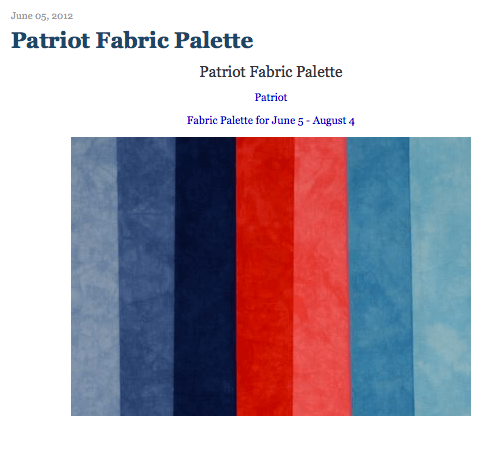 Generation Q Magazine just made it into print, after a year of online articles and features. Lots of potentially great stuff here!
Generation Q Magazine just made it into print, after a year of online articles and features. Lots of potentially great stuff here!
Insights from SewCalGal is my go-to site this year for machine quilting. My skills have improved tremendously, I did a tutorial for Darlene, and there are great giveaways – fantastic site!!
And last, but certainly not least, the Textile and Fiber Art List, a group of over 300 artists from 30 countries. Amazing eye candy! Take a trip through blogs and Etsy stores for artists in everything “textile and fiber” you can imagine! A wealth of awesome information.

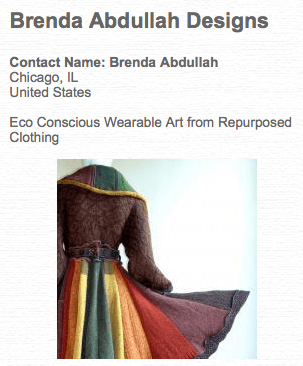
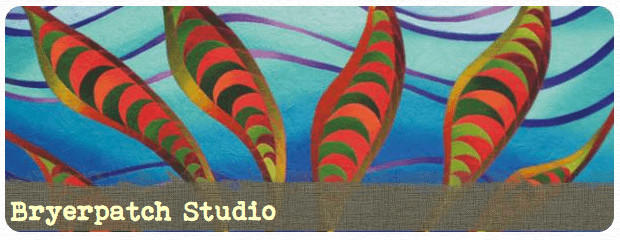
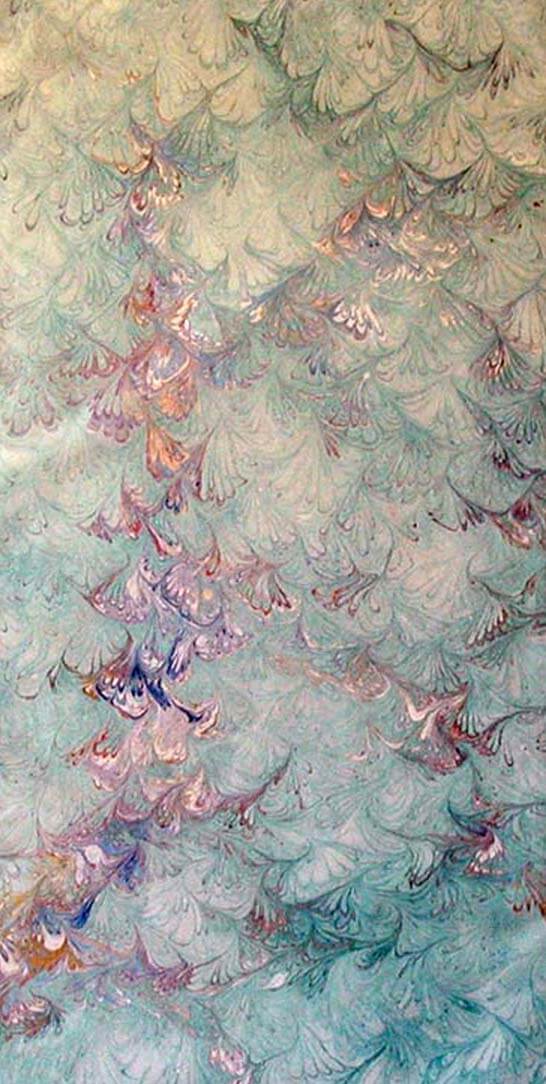
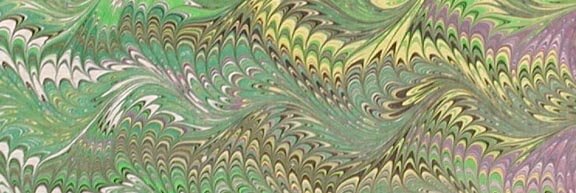
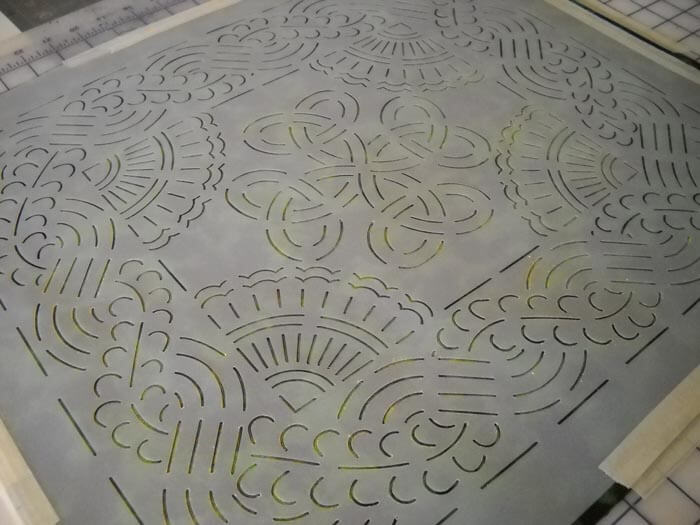
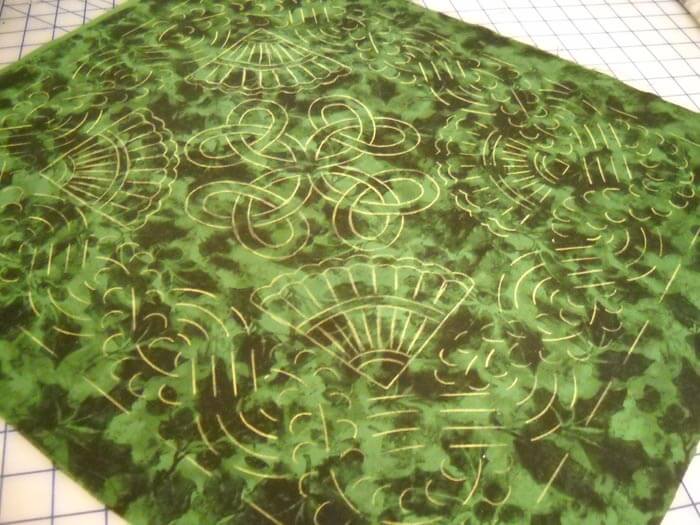
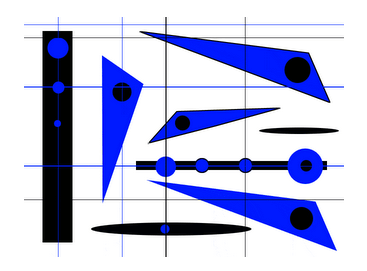
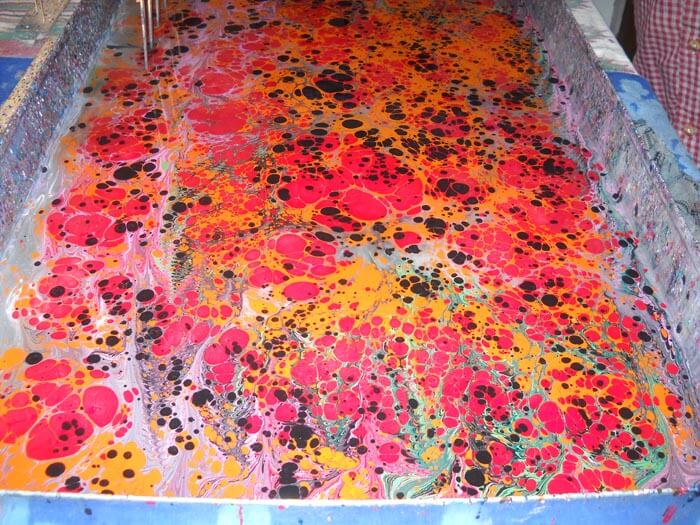
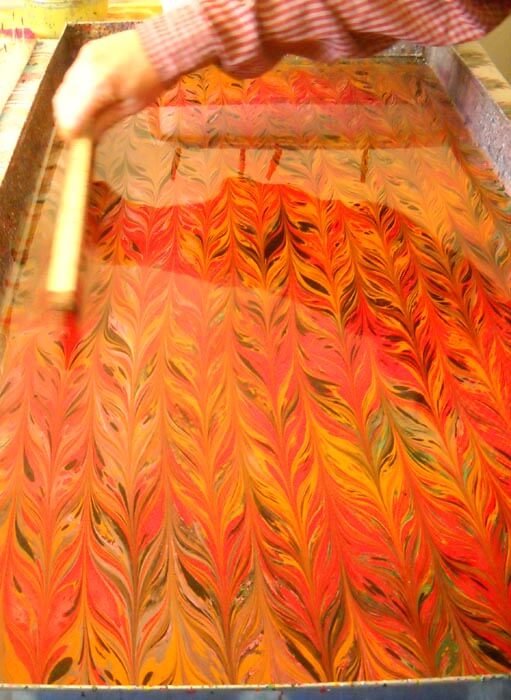
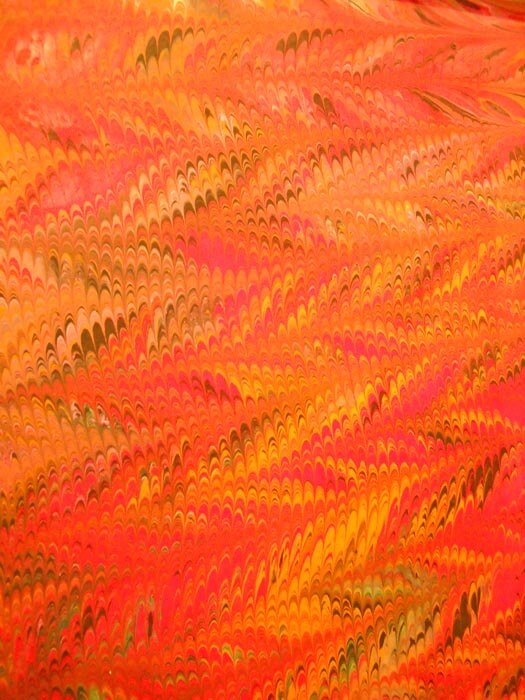
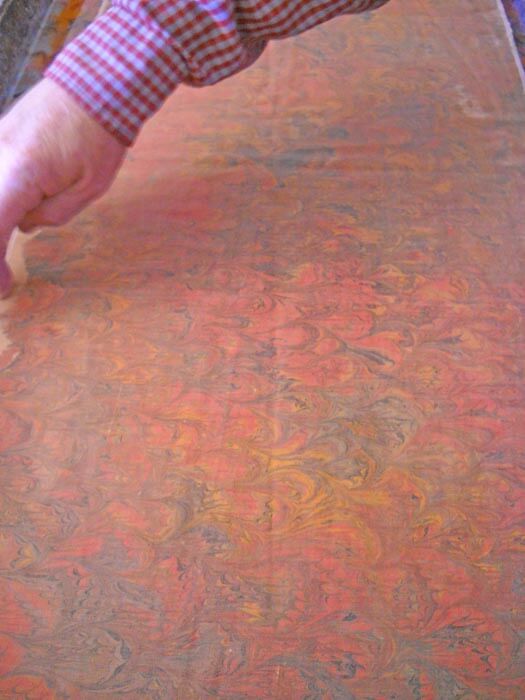
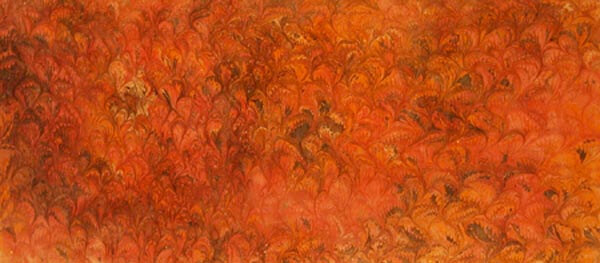

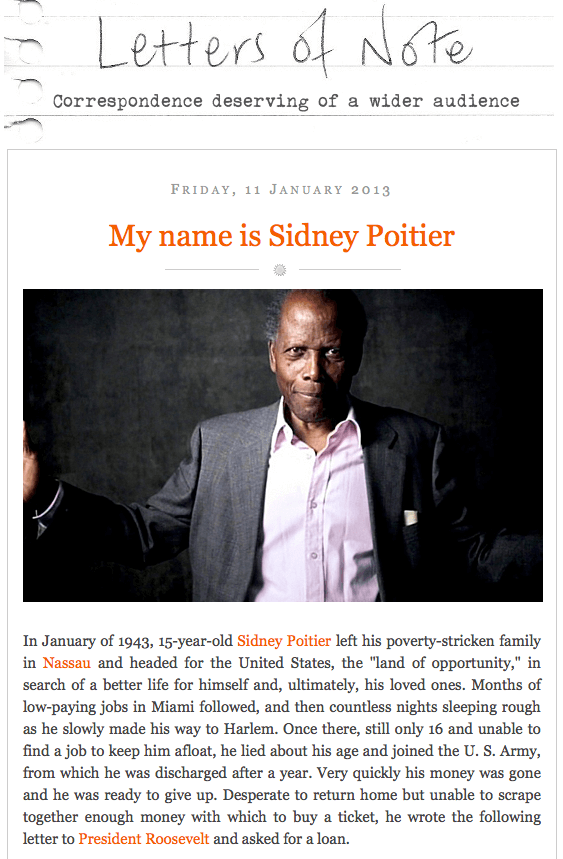

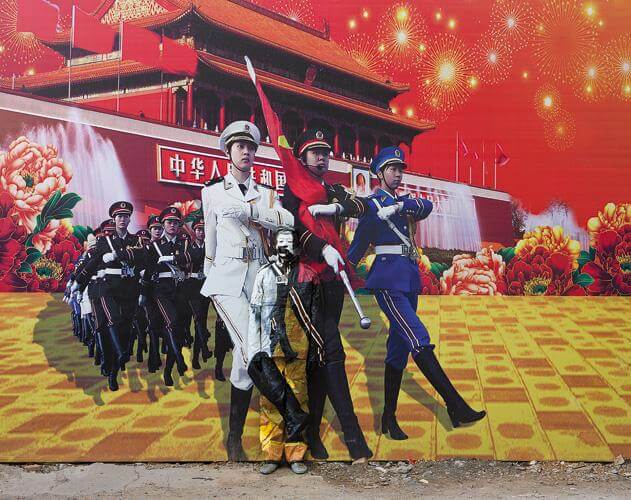
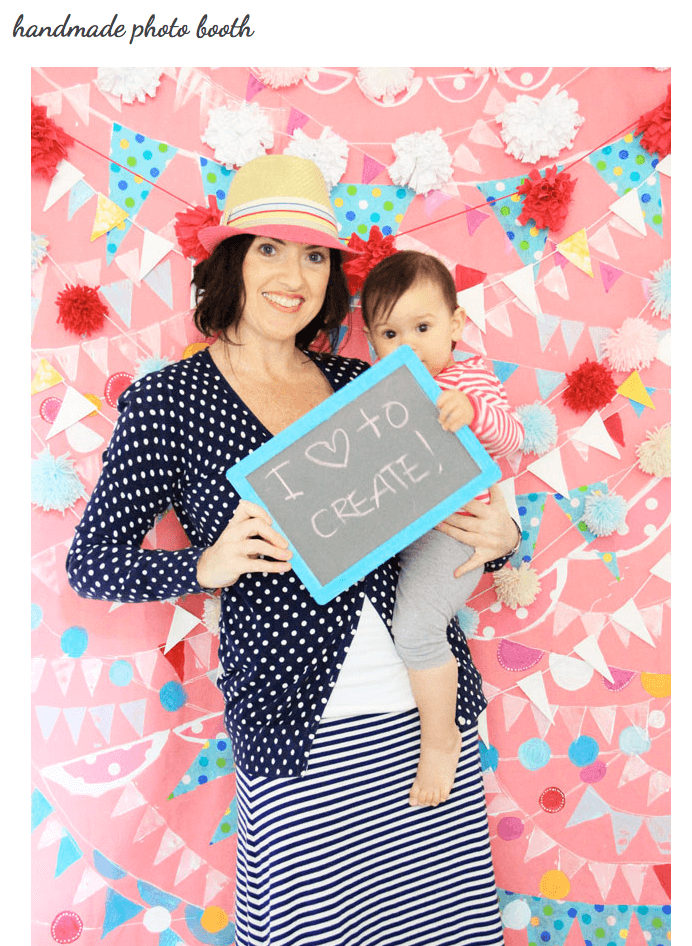
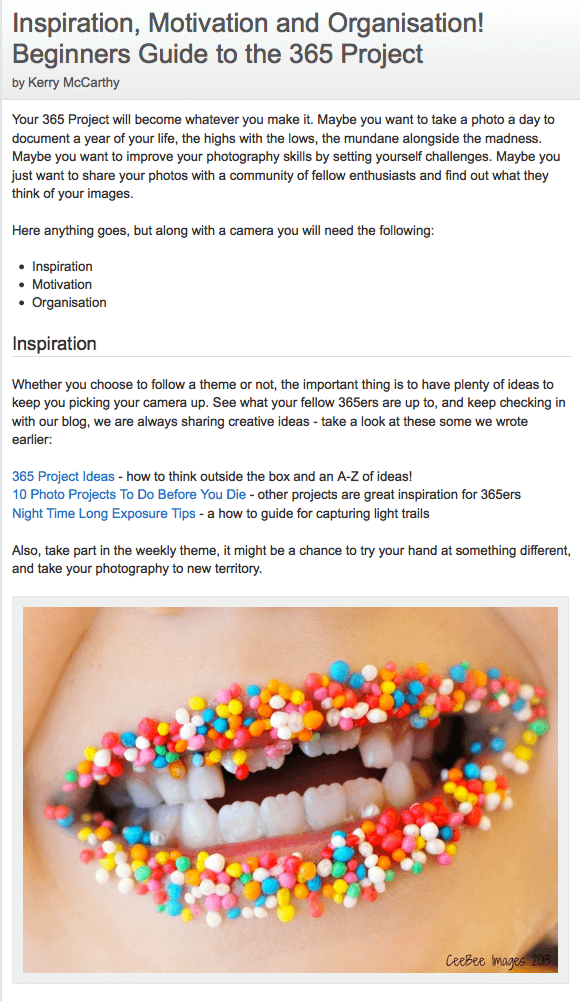

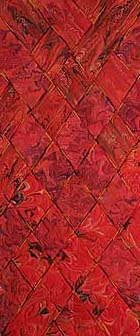


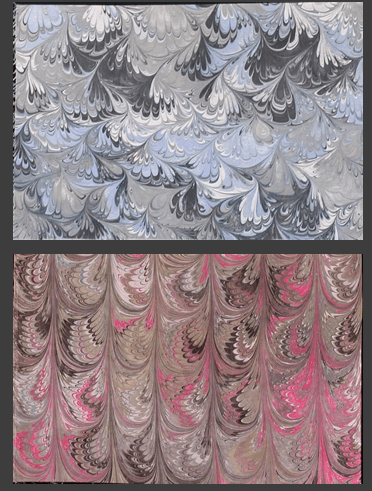
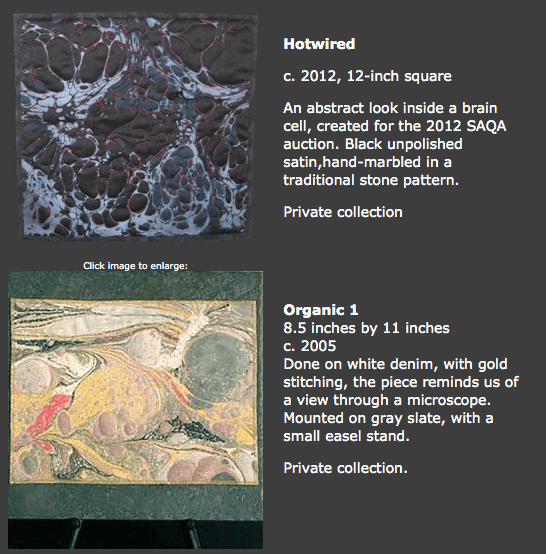
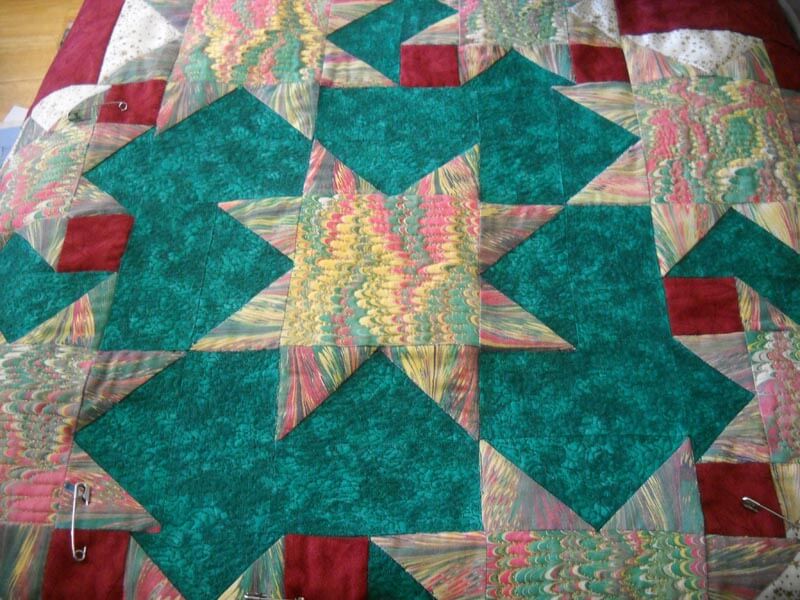



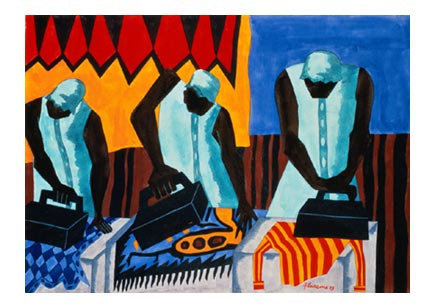
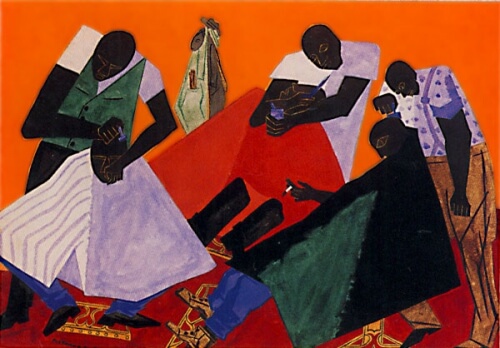
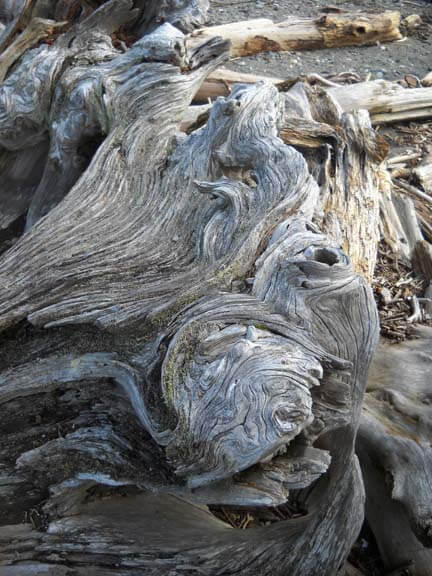
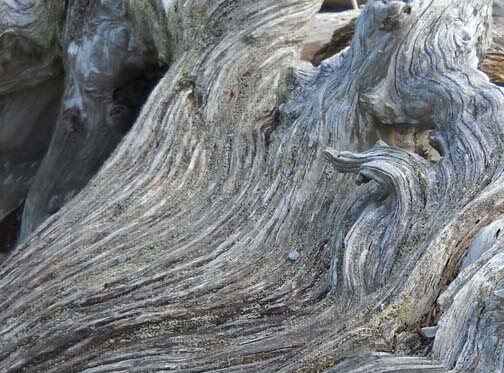
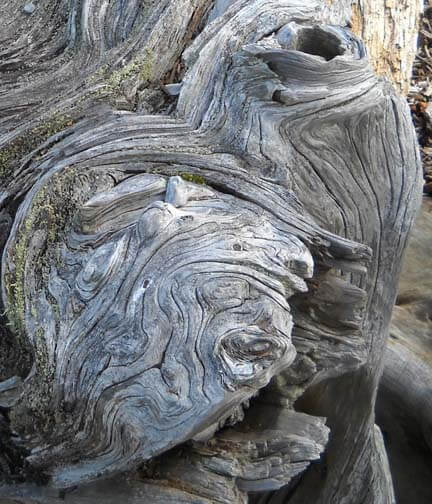

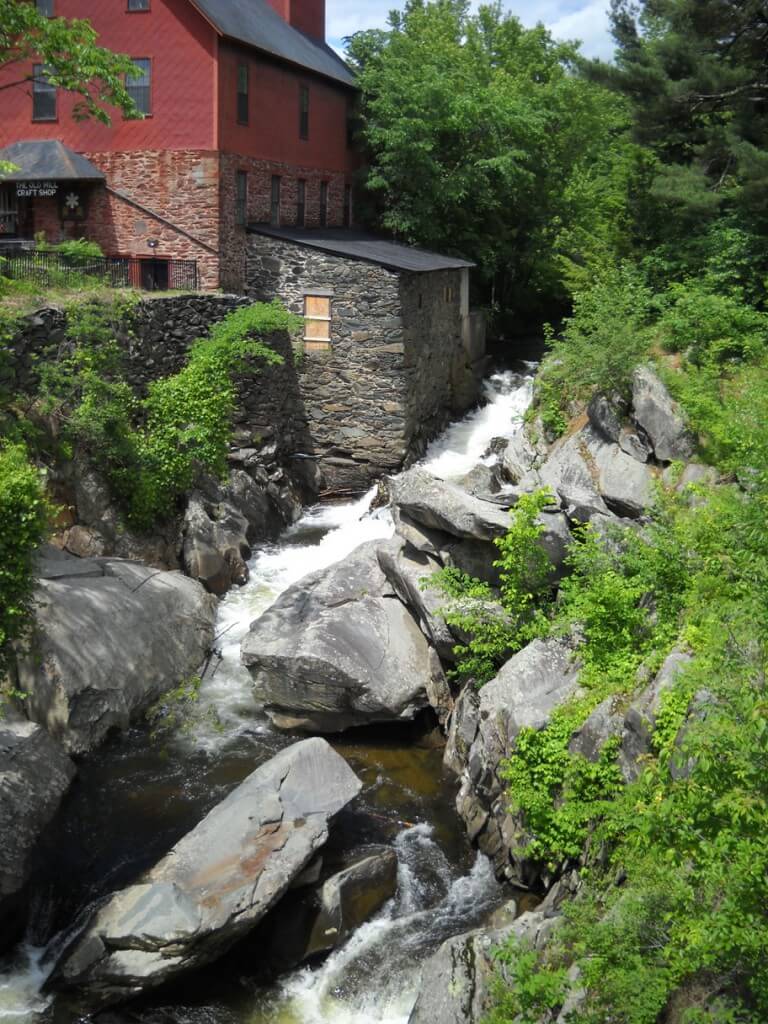
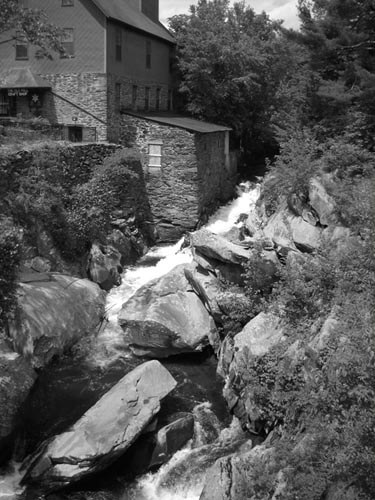
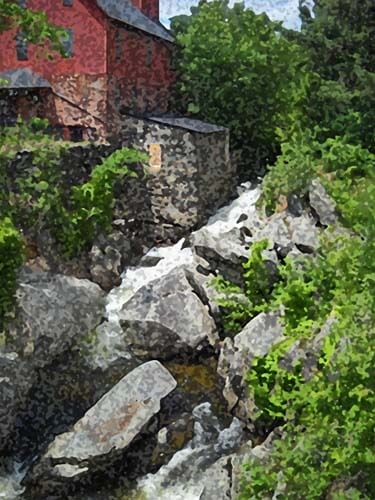
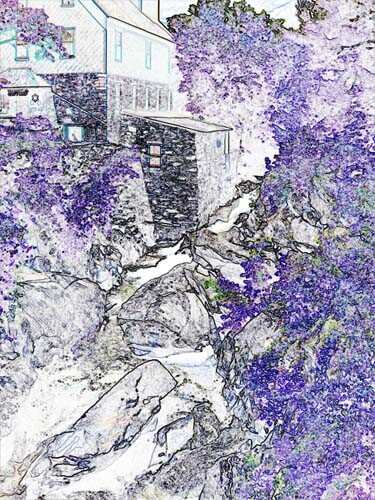
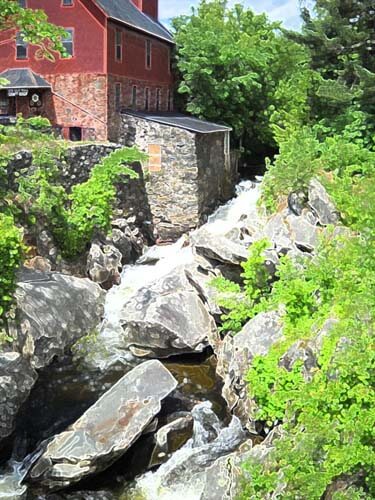
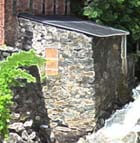
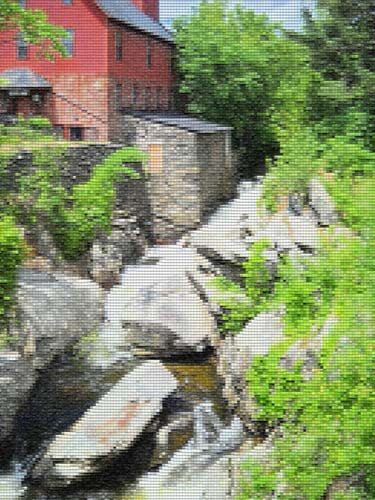
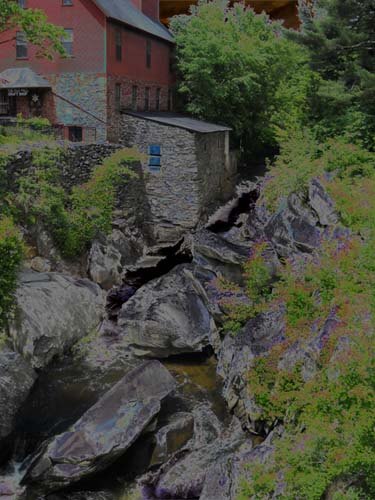
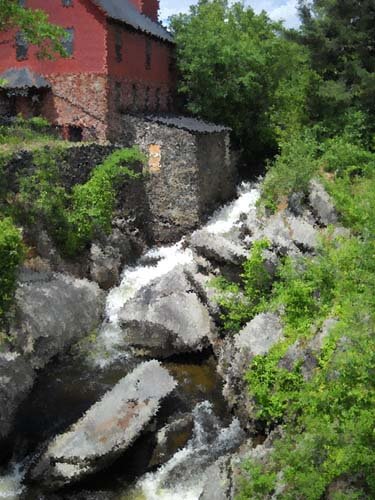
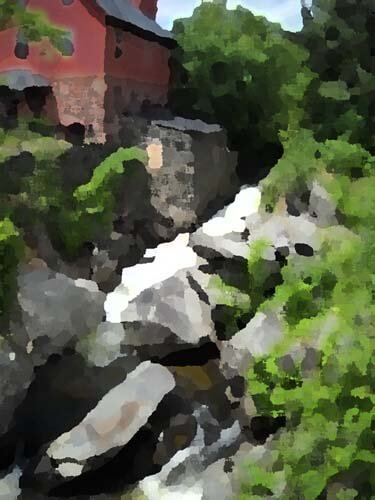
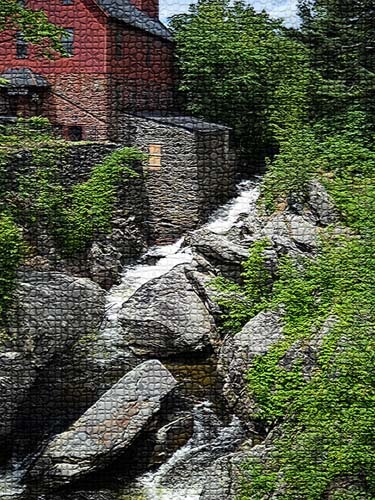
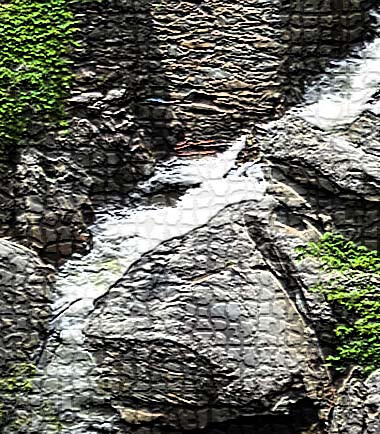
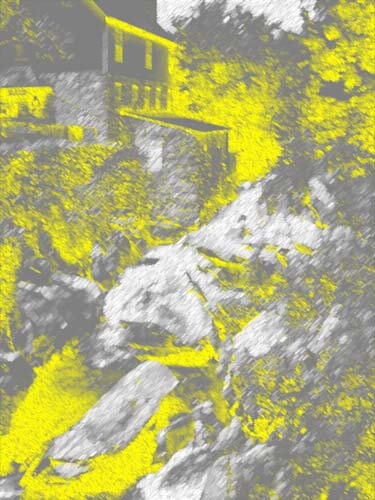
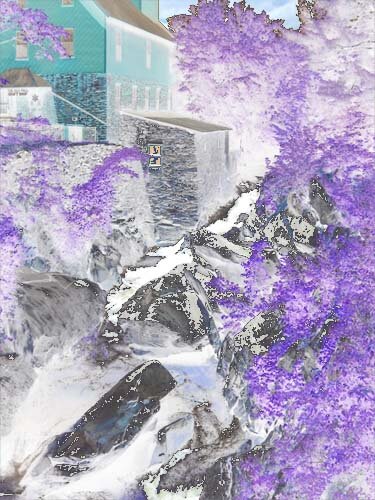
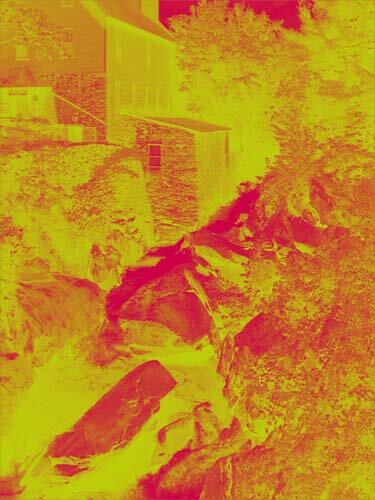
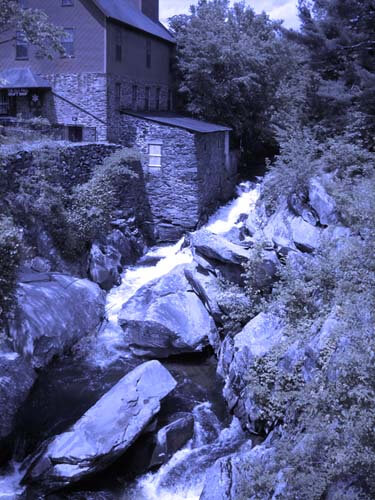

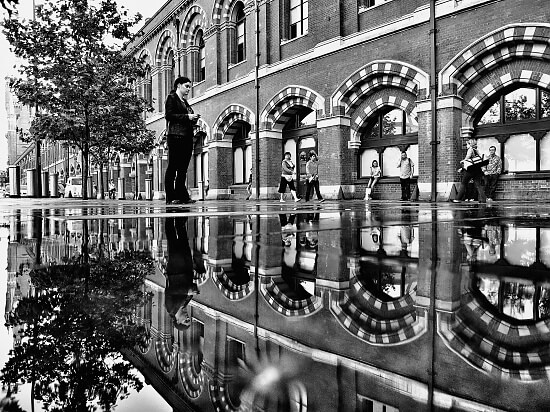

![redshift8_thumb[2]](https://www.marbledmusings.com/wp-content/uploads/2012/07/redshift8_thumb2.jpg)



